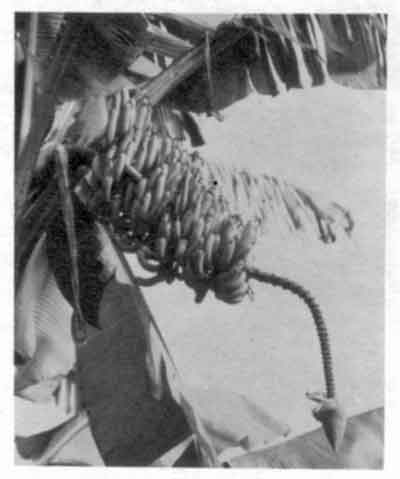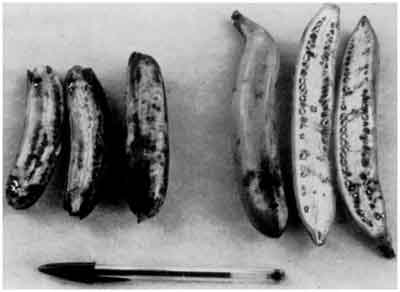
NATIVE BANANAS OF NORTH QUEENSLAND
SCIENTIFIC NAME: Musa species
FAMILY: Musaceae

There are two varieties of banana which are native to north Queensland. The most common one is Musa acuminata subsp. banksii, which is found from Ingham to the tip of Cape York. The second is Musa jackeyi, which is extremely rare and known only from Bellenden Ker and Cooktown. They are usually found in clearings or around the edges of rainforests and along watercourses.
They are also referred to as 'wild' bananas, which is distinct from 'feral' (cultivated bananas gone wild). They are fairly easily distinguished from cultivated bananas because the fruits consists mainly of hard dark seeds which are 3-5mm in diameter. Sir Joseph Banks encountered the wild banana (banksii) in his travels in the 18th Century, and noted in his diary that the fruit was so small and full of seed that it was scarcely edible.
Musa acuminata subsp. banksii grows to 3-4m in height, has a pendulous bunch and usually a yellow-green male bud (bell) though maroon forms exist. Musa jackeyi grows to 4-5m in height, has an erect bunch and a green male bud. The sap is unusual, being a red colour like that of cooked beetroot. The erect bunch and red sap are characteristics of the Australimusa group of bananas to which it belongs, compared to Eumusa, which includes most seeded and cultivated bananas. Musa jackeyi may be the same as Musa maclayi subsp. ailuluai from Papua New Guinea.
The photo on left is Musa acuminata subsp. banksii
Two additional wild species were reported as being present in north Queensland during the 19th Century - Musa fitzalani and Musa charlioi but there may have been errors in identification at the time. It is unlikely that these species exist, but I would greatly appreciate any information anyone has regarding sightings of other seeded bananas in the north.

The Queensland Department of Primary Industries has a particular interest in the native bananas, as they are known to harbour some pests and diseases of bananas which could be of some consequence to the banana industry. Their reaction to black Sigatoka (present in the Torres Strait) and Panama disease (southern Queensland) is currently being assessed to determine the likely effect the native banana population may play should these diseases be introduced to north Queensland.
On a more positive note, the native bananas may be important germplasm for banana breeding programs.
The photo on the right shows mature fruit of Musa acuminata subsp. banksii
DATE: May 1991
* * * * * * * * * * * * *
